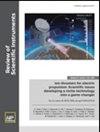A stretching apparatus with broad strain rate and temperature ranges for in-situ x-ray scattering measurements of polymers
IF 1.3
4区 工程技术
Q3 INSTRUMENTS & INSTRUMENTATION
引用次数: 0
Abstract
A stretching apparatus capable of conducting tensile tests over a broad strain rate range (10−3–250 s−1) and a wide temperature range (−75–250 °C) has been designed for polymeric materials, in particular the polymeric films. Specifically, this stretching apparatus can be combined with in situ ultrasmall-, small-, and wide-angle x-ray scattering (USAXS/SAXS/WAXS) measurements. The sample stretching is achieved through the synchronized rotation of rolls, powered by servo motors. The output electrical signal extracted from a torque sensor, when combined with the rotational speed of rolls and initial sample dimensions, enables the determination of the relationship between engineering stress (σ) and Hencky strain (ε). With the sample chamber and precise control loop, the prescribed temperature can be achieved using either hot airflow for heating or cold liquid nitrogen flow for cooling. By integrating this stretching apparatus with a high brilliance x-ray source at beamline BL10U1 in Shanghai Synchrotron Radiation Facility (SSRF) and detectors featuring ultrafast acquisition rates, it becomes possible to monitor multiscale structure evolutions of polymeric samples under harsh conditions involving high-speed loading combined with varying temperatures.用于聚合物原位 X 射线散射测量的拉伸装置,具有较宽的应变速率和温度范围
针对聚合物材料,特别是聚合物薄膜,我们设计了一种拉伸仪器,能够在较宽的应变速率范围(10-3-250 s-1)和较宽的温度范围(-75-250 °C)内进行拉伸试验。具体来说,这种拉伸仪器可与原位超小型、小型和广角 X 射线散射(USAXS/SAXS/WAXS)测量相结合。样品拉伸是通过伺服电机驱动的轧辊同步旋转实现的。从扭矩传感器提取的输出电信号与轧辊转速和样品初始尺寸相结合,可确定工程应力(σ)和亨斯基应变(ε)之间的关系。利用样品室和精确的控制回路,可以通过热气流加热或冷液氮流冷却来达到规定的温度。通过将这一拉伸装置与上海同步辐射设施(SSRF)BL10U1 光束线的高亮度 X 射线源和具有超快采集速率的探测器相结合,可以监测聚合物样品在高速加载和温度变化等苛刻条件下的多尺度结构演变。
本文章由计算机程序翻译,如有差异,请以英文原文为准。
求助全文
约1分钟内获得全文
求助全文
来源期刊

Review of Scientific Instruments
工程技术-物理:应用
CiteScore
3.00
自引率
12.50%
发文量
758
审稿时长
2.6 months
期刊介绍:
Review of Scientific Instruments, is committed to the publication of advances in scientific instruments, apparatuses, and techniques. RSI seeks to meet the needs of engineers and scientists in physics, chemistry, and the life sciences.
 求助内容:
求助内容: 应助结果提醒方式:
应助结果提醒方式:


